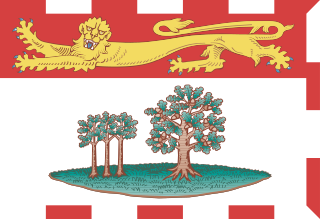
Prince Edward Island is one of the thirteen provinces and territories of Canada. While it is the smallest province in terms of land area and population, it is the most densely populated. The island has several nicknames: "Garden of the Gulf", "Birthplace of Confederation" and "Cradle of Confederation". Its capital and largest city is Charlottetown. It is one of the three Maritime provinces and one of the four Atlantic provinces.

The University of Prince Edward Island (UPEI) is a public university in Charlottetown, Prince Edward Island, Canada, and the only university in the province. Founded in 1969, the enabling legislation is the University Act, R.S.P.E.I 2000.

The Legislative Assembly of Prince Edward Island together with the lieutenant governor of Prince Edward Island form the General Assembly of Prince Edward Island. The Legislative Assembly meets at Province House, which is at the intersection of Richmond and Great George Streets in Charlottetown. Bills passed by the Assembly are given royal assent by the lieutenant governor in the name of the King of Canada.

Government House of British Columbia is the official residence of the lieutenant governor of British Columbia in Victoria and is nominally a residence of the Canadian monarch. It has casually been described as "the Ceremonial Home of all British Columbians." It stands in the provincial capital on a 14.6 hectares estate at 1401 Rockland Avenue; while the equivalent building in many countries has a prominent, central place in the capital, the site of British Columbia's Government House is relatively unobtrusive within Victoria, giving it more the character of a private home.

Government House of Manitoba is the official residence of the lieutenant governor of Manitoba, as well as that in Winnipeg of the Canadian monarch. It stands in the provincial capital, on the grounds of the Manitoba Legislative Building, at 10 Kennedy Street; unlike other provincial Government Houses in Canada, this gives Manitoba's royal residence a prominent urban setting, though it is surrounded by gardens.
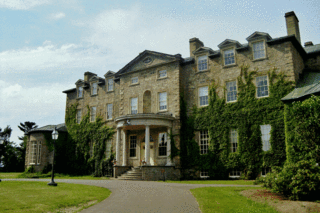
Government House is the official residence of the Lieutenant Governor of New Brunswick, as well as that in Fredericton of the Canadian monarch. It stands on a 4.5 ha estate along the Saint John River in the provincial capital at 51 Woodstock Road; while the equivalent building in many countries has a prominent, central place in the territorial capital, the site of New Brunswick's Government House is relatively unobtrusive within Fredericton, giving it more the character of a private home.
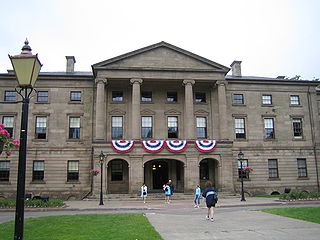
Province House is where the Prince Edward Island Legislature, known as the Legislative Assembly of Prince Edward Island, has met since 1847. The building is located at the intersection of Richmond and Great George Streets in Charlottetown; it is Canada's second-oldest seat of government.

Government House was the official residence of the lieutenant governor of Upper Canada and Ontario, Canada. Four buildings were used for this purpose, none of which exist today, making Ontario one of four provinces not to have an official vice-regal residence.
The King's Printer is typically a bureau of the national, state, or provincial government responsible for producing official documents issued by the King-in-Council, Ministers of the Crown, or other departments. The position is defined by letters patent under the royal prerogative in various Commonwealth realms.

Government House of Nova Scotia is the official residence of the lieutenant governor of Nova Scotia, as well as that in Halifax of the Canadian monarch. It stands in the provincial capital at 1451 Barrington Street; unlike other provincial Government Houses in Canada, this gives Nova Scotia's royal residence a prominent urban setting, though it is still surrounded by gardens.

Government House in Regina, Saskatchewan, Canada, is the official office of the lieutenant governor of Saskatchewan. It was first constructed as a residence for the lieutenant governor of the North-West Territories, whose territorial headquarters were in Regina. When the provinces of Saskatchewan and Alberta were created out of the Territories in 1905, Regina became the capital of Saskatchewan and Government House became the official residence of the lieutenant governor of Saskatchewan. It was vacated in 1944 and then returned to official ceremonial use in 1984.

Government House is the former official residence of the lieutenant governors of Alberta. Located in Edmonton's Glenora neighbourhood, since 1964 the restored and repurposed building has been used by the Alberta provincial government for ceremonial events, conferences, and some official meetings of the caucus.

By the arrangements of the Canadian federation, the Canadian monarchy operates in Nova Scotia as the core of the province's Westminster-style parliamentary democracy. As such, the Crown within Nova Scotia's jurisdiction is referred to as the Crown in Right of Nova Scotia, His Majesty in Right of Nova Scotia, or the King in Right of Nova Scotia. The Constitution Act, 1867, however, leaves many royal duties in the province specifically assigned to the sovereign's viceroy, the lieutenant governor of Nova Scotia, whose direct participation in governance is limited by the conventional stipulations of constitutional monarchy.

By the arrangements of the Canadian federation, Canada's monarchy operates in Alberta as the core of the province's Westminster-style parliamentary democracy. As such, the Crown within Alberta's jurisdiction is referred to as the Crown in Right of Alberta, His Majesty in Right of Alberta, or The King in Right of Alberta. The Constitution Act, 1867, however, leaves many royal duties in Alberta specifically assigned to the sovereign's viceroy, the Lieutenant Governor of Alberta, whose direct participation in governance is limited by the conventional stipulations of constitutional monarchy.

By the arrangements of the Canadian federation, Canada's monarchy operates in New Brunswick as the core of the province's Westminster-style parliamentary democracy. As such, the Crown within New Brunswick's jurisdiction is referred to as the Crown in Right of New Brunswick, His Majesty in Right of New Brunswick, or the King in Right of New Brunswick. The Constitution Act, 1867, however, leaves many royal duties in the province specifically assigned to the sovereign's viceroy, the lieutenant governor of New Brunswick, whose direct participation in governance is limited by the conventional stipulations of constitutional monarchy.

By the arrangements of the Canadian federation, the Canadian monarchy operates in Prince Edward Island as the core of the province's Westminster-style parliamentary democracy. As such, the Crown within Prince Edward Island's jurisdiction is referred to as the Crown in Right of Prince Edward Island, His Majesty in Right of Prince Edward Island, or the King in Right of Prince Edward Island. The Constitution Act, 1867, however, leaves many royal duties in Prince Edward Island specifically assigned to the sovereign's viceroy, the lieutenant governor of Prince Edward Island, whose direct participation in governance is limited by the conventional stipulations of constitutional monarchy.

Victoria Park is a waterfront park in the city of Charlottetown, Prince Edward Island, Canada.
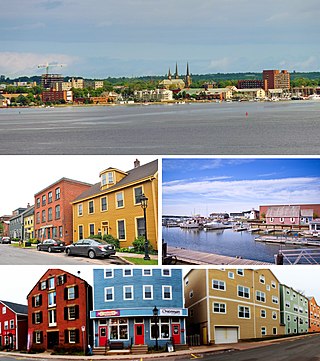
Charlottetown is the capital and largest city of the Canadian province of Prince Edward Island, and the county seat of Queens County. Named after Queen Charlotte, Charlottetown was an unincorporated town until it was incorporated as a city in 1855.
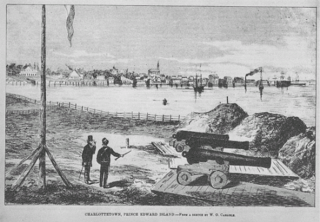
The History of Charlottetown can be traced back to the original French military settlement established on the site in 1720. Over the years Charlottetown has grown to become the largest and most important city on Prince Edward Island.

To mark the Platinum Jubilee of Elizabeth II's accession as Queen of Canada, lieutenant governors and territorial commissioners across the country dedicated specially-created gardens in their respective province or territory. Each of the 13 gardens include plants suited to the local climate, tobacco being commonly incorporated to represent the relationship between Canada's Crown and Indigenous peoples. The tobacco seeds were drawn from plants grown for the chapel royal in Toronto.





















